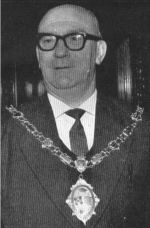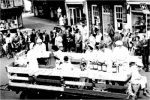
The first Carnival in the current series, took place in the summer of 1964 and was planned to be a 'one-off event'. It was
part of a campaign to raise money for undernourished countries called 'Freedom from Hunger'. This was a forerunner to later
campaigns like Live Aid and Comic Relief.
Mr. George Warne (pictured left) inherited the campaign in 1963 in his role as chairman of Braintree Urban District Council.
"I had to think of something different," he recalled in an interview in 1984. "I consulted friends and asked
them what they thought." It was another councilor, Mr. John Arnold, who suggested the idea of a Carnival. It was 'as simple
as that' but having the idea was the easy bit.
|
|
A meeting with representatives of the town's organisations was arranged. The
idea of a carnival was discussed and everybody said it was "an
idea" but all insisted they take it back to their organisation's."I
remember leaving awfully depressed," said George Warne.
Officers at the U.S. Air Force Base in Weathersfield liked the idea and with their help the idea finally got underway. A
committee was formed and a week of fun and fund-raising was planned.
|

But not everything went to plan. "It was utter chaos that day," said fellow organiser Mike Hawes. All the help
was voluntary and nobody was sure what to expect, it could easily have been a disaster. Some of the help was over
enthusiastic. The float built for the Carnival Queen, Vicky Langham, was almost too big and heavy to fit on to the trailer.
It was then too high and Vicky and her attendants, had to lie down to pass under a railway bridge.
A double line of over 90 floats stretched half a mile from Lakes Road to Clockhouse
Way and despite the chaos, they left on time. Thousands of people lined the streets
to watch the procession. Braintree had not seen scenes like it since the coronation
of Queen Elizabeth II in 1952.
Things looked ominous when a float of Joseph Bradbury Ltd broke down but the delay
was short lived. One child was lost; a few minor casualties required first aid and
a brief fight broke out in the evening. Nothing could detract from its success and
yes the child was found safely.
The event raised in the region of £400.
|
|
The Carnival has never been cancelled regardless of the weather or circumstances.
The strong traditions of the past can still be seen in today's event. The procession
route, the field, the Queen and two court, the emphasis on free entertainment for
all the family: these all find their roots from those early years. However, it has
never stood still and the outcome is an event that has slowly evolved and grown
with time.
|
|
One of the more notable early changes was the move away from a 'Carnival Week'.
The weekly events included such activities as a talent contest, football matches,
fashion shows and musical concerts.
The selection of the Carnival Queen has also altered. Weekend dances would be held
at surrounding villages to choose entrants for a Grand Final. This lost its popularity
during the early seventies and since then various methods have been used to both
select and then crown the successful contestant. The success of these has been
variable to say the least.
Every year someone levels the complaint 'it's the same as last year'. This cannot
be denied, the event is difficult enough to organise as is without making sweeping
changes every year. It's tweaked and prodded, bits added and bits lost and hopefully,
generally improved.
|
The continued commitment of committee members ensures that:
>> Sideshows are re-painted and repaired during the winter months (or late Saturday morning).
>> Attendance at other Carnivals by the Queen and court and naturally the upkeep of the float.
>> Since 1971, the annual organisation of a sponsored walk along local footpaths.
>> Christmas visits to 'Old Folks' Homes.
|
|
In all of this time, perhaps the most fundamental change has been the objectives of
the Carnival Committee. Initially it was simply:
To raise money for a general fund
to be distributed to local charitable causes.
During the 1970's this was expanded to:
. . . and provide entertainment
for the town.
Later the emphasis changed and to this day the objectives are:
To provide entertainment for the
town and to raise money for a general fund to be distributed to local
charitable and good causes.
|

